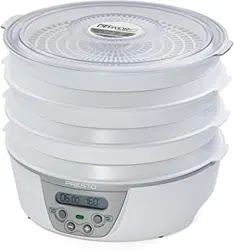Loading ...
Loading ...
Loading ...

8
Vegetable Preparation
Pretreatment
water or steam blanching
Average Drying Time
Peppers and pimientos
Remove stem, core, and inner partitions. Cut
into¼˝strips.
None 5–10 hours
Potatoes Peelandcutinto¼˝slices.
water 5–6 minutes
steam 6–8 minutes
4–8 hours
Summer squash and zucchini Trimends.Cutinto¼˝slices.
water 1½ minutes
steam 2½–3 minutes
4–6 hours
Tomatoes Peel,ifdesired.Cutintosections¾˝wide. None 6–11 hours
Uses
Dried vegetables have a unique flavor and texture and are best used as ingredients for soups, stews, casseroles, and sauces rather than
stand-alone side dishes. When using in soups, dried vegetables can be added without soaking. Dried vegetables used for other purposes
need to be soaked before cooking. To soak, start with 1½ to 2 cups of boiling water for every 1 cup of dried vegetables. Soak for 1 to 2
hours or until vegetables have returned to nearly the same size they were before dehydrating. Additional water should be added as needed
during the soaking process. After soaking, simmer the vegetables in the soaking water until tender, allowing excess water to evaporate.
Drying Herbs
Drying fresh herbs allows you to have a ready supply of economical herbs that are available to use all through the year. To retain the best
flavor of your herbs, it is recommended that you dry them at the lowest temperature setting, 95°F [35°C].
Selection and Preparation
Pick herbs for drying just before the flowers first open. These herbs will be the most flavorful. The best time to pick herbs is in the early
morning just after the dew has evaporated. Rinse leaves and stems in cool water to remove any dust or insects and then gently shake to
remove excess water. Remove dead and bruised leaves or stems. Large leafed herbs, such as basil, sage, and mint, should be removed
from their stems for faster drying. Smaller leafed herbs can be left on their stem and removed after drying. Placing the herbs on a mesh
screen will help prevent them from falling through the grates in the tray as they dehydrate.
Determining Dryness
Herbs are acceptably dry when they are crispy and crumble easily. Refer to the Herb Drying Guide below and begin checking the herbs at
the beginning of the average drying time range. Remove a few herbs from each dehydrator tray and allow to cool to room temperature.
If the herbs do not crumble easily, recheck every hour.
Packaging and Storage
Dried leaves are best stored whole and then crumbled when needed. Follow “Packaging and Storage” information on page 4.
Uses
Most dried herbs are 3 to 4 times stronger than the fresh herbs, therefore when using dried herbs in a recipe that calls for fresh herbs, use
¼to⅓oftheamountcalledforintherecipe.
Herb Drying Guide
Dry herbs at 95°F [35°C].
Herb Average Drying Time Herb Average Drying Time Herb Average Drying Time
Basil leaves* 10–15 hours Fennel 3–5 hours Rosemary leaves 8–12 hours
Bay leaves 5–7 hours Marjoram leaves 9–12 hours Sage leaves 12–16 hours
Chives 9–15 hours Mint leaves 9–14 hours Tarragon leaves 5–7 hours
Cilantro leaves 6–8 hours Oregano leaves 9–12 hours Thyme leaves 4–6 hours
Dill leaves 3–5 hours Parsley leaves 6–8 hours
* Break veins to speed drying.
Loading ...
Loading ...
Loading ...
